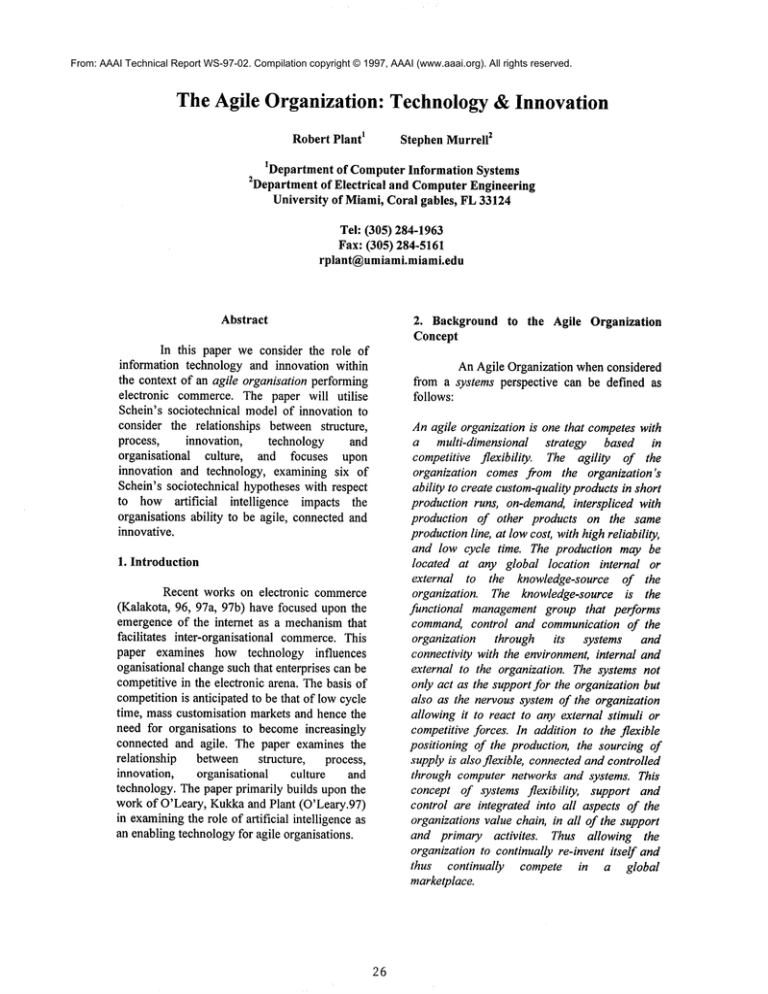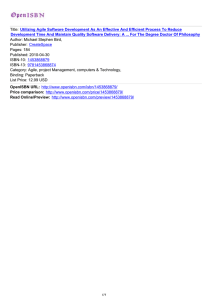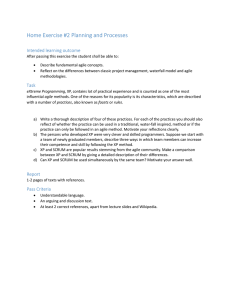
From: AAAI Technical Report WS-97-02. Compilation copyright © 1997, AAAI (www.aaai.org). All rights reserved.
The Agile Organization: Technology & Innovation
~
Robert Plant
2Stephen Murrell
1Department of ComputerInformation Systems
2Departmentof Electrical and ComputerEngineering
University of Miami,Coral gables, FL33124
Tel: (305) 284-1963
Fax: (305) 284-5161
rplant@umiami.miami.edu
Abstract
2. Background to the Agile Organization
Concept
In this paper we consider the role of
information technology and innovation within
the context of an agile organisation performing
electronic commerce. The paper will utilise
Schein’s sociotechnical modelof innovation to
consider the relationships between structure,
process,
innovation,
technology
and
organisational
culture, and focuses upon
innovation and technology, examining six of
Schein’s sociotechnical hypotheses with respect
to how artificial
intelligence
impacts the
organisations ability to be agile, connected and
innovative.
1. Introduction
Recent works on electronic commerce
(Kalakota, 96, 97a, 97b) have focused upon the
emergence of the internet as a mechanismthat
facilitates inter-organisational commerce.This
paper examines how technology influences
oganisational change such that enterprises can be
competitive in the electronic arena. The basis of
competitionis anticipated to be that of low cycle
time, mass customisation markets and hence the
need for organisations to becomeincreasingly
connected and agile. The paper examines the
relationship
between structure,
process,
innovation,
organisational
culture
and
technology. The paper primarily builds upon the
work of O’Leary, Kukka and Plant (O’Leary.97)
in examiningthe role of artificial intelligence as
an enabling technologyfor agile organisations.
26
An Agile Organization when considered
from a systems perspective can be defined as
follows:
An agile organization is one that competes with
a multi-dimensional
strategy
based in
competitive flexibility.
The agility of the
organization comes from the organization’s
ability to create custom-quality products in short
production runs, on-demand, interspliced with
production of other products on the same
productionline, at low cost, with high reliability,
and low cycle time. The production may be
located at any global location internal or
external to the knowledge-source of the
organization. The knowledge-source is the
functional management group that performs
command, control and communication of the
organization
through its systems and
connectivity with the environment, internal and
external to the organization. The systems not
only act as the support for the organization but
also as the nervous system of the organization
allowing it to react to any external stimuli or
competitive forces. In addition to the flexible
positioning of the production, the sourcing of
supply is also flexible, connected and controlled
through computer networks and systems. This
concept of systems flexibility,
support and
control are integrated into all aspects of the
organizations value chain, in all of the support
and primary activites.
Thus allowing the
organization to continually re-invent itself and
thus continually
compete in a global
marketplace.
Fromthis it can be seen that the ability of an
organization to be considered agile is complex
and multidimensional.
¯
3. Technology Innovation and Organizations
¯
The transformation of an organization
from one state to another requires vision and
leadership from senior management,but further
it requires that the organization possess the
property of organizational innovation. The area
of organizational innovation has been described
by Schein in relation to traditional organizations
and the transformational processes that they
experience (Schein,1994). Wewill utilize his
sociotechnical
model (see Figure 1)
organizational innovation to consider the context
in whichan agile organization exists.
¯
¯
¯
The achievementof flexibility in all aspects
of the organizations value chain
That information systems are the primary
drivers of that flexibility.
Inter-corporate relationship managementis
vital to the organizations ability to position
itself within electronic communities of
commerce
Humanresources are based upon knowledge
workers
Creative interaction between knowledge
workers, systems and extra-corporate
entities facilitates the competitivenessof the
organization
Having created a set of cultural assumptions,
their impact upon the other sociotechnical
processes can nowbe assessed.
Underlying cultural Assumptions
State of Information Technology
Organizational Structure
1
Organizational Process
Organizational Innovation
Figure 1. A Soeioteehnieal Modelof Organizational Innovation [Sehein.94]
3.1 Underlying Cultural Assumptions
3.2. Information Technology
It has been determined (Schein,1985)
that a primary issue in competitiveness and
organizational
adaptability
is that of
organizational
culture. The culture of an
organization manifests itself ultimately in its
mission and vision, which is an embodimentof
the collective philosophy of the organization. In
an agile organization the cultural assumptions
are based uponfactors such as:
27
The organizational culture will carry
over and directly affect the information
technologythat is present within an organization.
The technology utilized appears in response to,
and in support of, that culture. The cultural
characteristics outlined above, all point to the
need for a flexible and open systems culture.
These systems
will be increasingly
interconnected
both intraand inter-
organizationally,
following and creating
standards and protocols. Further the use of
systems to reduce cycle time requires an
increased operational dependence and hence
operational risk upon critical systems. The
support systems can be easily managedand even
outsourced to third parties, the developmentof
new strategic systems being an aspect of the
research
and development
arm of the
organization.
These new strategic systems
evolving quickly into the operational usage, both
to maintain competitiveness and to increase
flexibility. The vital componentthat holds all
these technological aspects together is the human
factor, the knowledge workers at both the
systems level and the strategic level. The
organization
being based upon the use of
sophisticated technologies requires its workforce
to be equally skilled and flexible.
technology of an organization
innovative enterprise.
Adaptation of Schein’s assumptions
allows the underlying nature of the agile
environmentto be seen moreclearly.
1.
2.
3.
3.3. Organizational Structure
4.
The organizational culture also directly
affects the organizational structure. The nature
and configuration
of work practices
and
processes. The socio-technology model assumes
that the structure can not be separated from the
culture of the organization. This can be applied
to the agile environment where the culture of
change through information technology is
accepted and that this acceptance leads to the
flexibility
of working practices
by the
employees, and flexibility of processes within
the organization.
to create an
5.
6.
7.
The marketplace is in continious state of
flux but that the organization can be
continually repositioned to be effective in
that market.
The knowledge workers of an agile
enterprise are themselves in a continious
state of skill enhancement to match the
needs of the market.
The agile organization positions itself to
both be successful
in a short term
relationship and a brief life-span market
place. It also capitalizes uponits experiences
to be successfully positioned for long-term
organizational success.
The organization
can work in several
markets at the same time each of which have
differing
competitive time planning
horizons.
Markets
involve
inter-corporate
communitiesof interest.
The form of the market place is in part or
totally electronic.
Subcultures exist within the marketplace.
Fromthis we can identify what Schein defines as
characteristics of an information technology for
innovation, and adapt those characteristics for an
agile organization. These characteristics are
defined through a series of hypothesis
(Schein,1994), six of which will be examined
light of the agile competitive philosophy in
section four.
3.4. Organizational Processes
The culture adopted by the organization
is also reflected
in the nature of the
organizational
processes
and
the
communicationsthat surrounds these processes.
The transformation of the value chain processes
through technology impacts both the support and
primary activities. The focus of these changes
being the move towards flexibility
of the
processes, both in terms of function and speed of
operation: the fundamental basis of the agile
organization.
4. Information Technologyfor Innovation
In this section we will examinethe agile
organisation through six of Schein’s hypothesis
in relation to information technology, with
special emphasis placed upon the role of
artificial intelligence to each.
3.5. Organizational Innovation
The sociotechnology model of Schein
identified the relationships that occur between
the culture, structure, processes and information
28
4.1 Networking Capacity:
networked capacity,
both internally
and
externally, the intra and inter-nets, confirming
Hypothesis IT1. Wecan extrapolate the third era
and consider the evolution of the technologies in
this era. This is illustrated in Figure 3 and shows
that the organisation progresses through a series
of levels of technological competence and
understanding. The progression starts with
developmentof intra nets with basic client server
technologies, followed by inter-connectivity via
standard protocols. A phase of web construction
follows and the creation of secure transaction
facilities through the Secure HyperText Transfer
Protocol (S-HTTP). The highest phases
organisational connectivity are centered around
the use and manipulation of knowledge, both
internal knowledgeand external knowledge. The
Hypothesis ITI: The capacity of an organization
to innovate to the extent that it has total
networking capacity(Schein, 1994)
The agile organization can be defined as the
complete networked organization.
The
progression of the organization from a support,
unconnected organization to this agile state
follows the three stages of Nolan and Seger’s
model in which three, S-shaped curves that
"reflect organisational
learning on major
informational technologies" (Nolan and Seger,
1993), these curves representing three eras: the
data processing era; the micro era; and the
networkera (See Figure 2).
Organisational
Learning
about
Information
Technology
Network Era
I
1960
1980
1995
2010
Year
Industrial
Economy
Information
Economy
Transitional
Economy
"Period of
Creative
Destruction"
"Period of
Transformed
Enterprises"
Virtual
Economy
"Period of
Virtualization "
Figure 2: Stages Theory Re-examined
In considering the agile organisation
and the networked era we identify
the
organisation
as moving towards a total
knowledgeis used operationally, tactically and
strategically by the agile organisation in its
relations with external entities. The use of
29
knowledge and the creation of a highly
connected organisation is achieved through the
utilisation of artificial intelligence. The basis of
which is the use of intelligent
agents,
knowledge-based systems and virtual reality
models, through standards and applications built
around those standards.
The ability
to route and filter
information adequately as the volume of
information continues to grow is an area where
artificial intelligence is both applicable and
indispensable.
The combination of the two
hypothesis indicates the need for organisationsto
perform wider environmental scanning with the
Ontologies
KQML
KIF
Organisational
Learning about
Information
Technology
VRML
Java
HTML
S-HTTPI
TCP/IP
I
Client Server Netware
Time
Figure 3: The ExpanedNetwork era
4.2 Routing and Filtering Capacity
Hypothesis
IT2A; The capacity
of an
organization to innovate increases to the extent
that it can open and close channels as needed
(Schein, 1994).
Hypothesis
IT2B; The capacity
of an
organization to innovate increases to the extent
that it can filter informationinto the channelsas
needed (Schein, 1994).
The agile organization is based upon
the ability to innovate but also to respond to
market demandsfaster and more profitably than
any other type of organization. This is grounded
in the ability to open and close channels to meet
specific and often novel market conditions and
that the organizations self-understanding of its
processes, through its virtual value chain allows
superior informationfiltering to occur.
3O
ability to access morechannels than ever before.
These activities can be performed in part or
entirely by autonomousintelligent agents. The
leading area in whichthis is occurring is that of
smart procurement,
in which product
information can be obtained autonomously and
remotely by agents over a networksuch as the
internet., e.g., part.net, commerce.net. The
procurement process can occur autonomously
through arbitrage performed by neural nets or
knowledge-based systems which analyse and
filter
the quotes from vendors against
organisational requirements, previous histories
and profiles of the vendor.
Filtering can also take place through the
organisations connectivity with the external
world and external networks through intelligent
search
engines
such as SemioMap
(www.semio.com/) which organises search
results
by concept and aims to uncover
relationships between internet and intranet
documents.
distributed setting as a part of the Shared
Dependency Engineering (SHADE) project
within which manyagents that adhere to those
protocols have been built and are available e.g.,
contents-based router, matchmaker, control
agent,
ParMan
(http://wwwksl.stanford.edu/knowledgesharing/agents.html).
As the connectivity of
organisations increases so does the necessity to
interact not only through data but visually. This
can be achieved through virtual reality modeling
and is supported by VRML.The supplier-buyer
relationship of manyorganisations is becoming
increasingly dependent upon low cycle-times
and high quality work, a circumstance that
increasingly requires connectivity through VR
modeling. The connectivity
theme is a
continuing one in research, as is that of shared
information, as can be seen with the ARPA
program in knowledge sharing that aims to
facilitate
the reuse of knowledge bases and
knowledge-based systems. The ability to link
these standards protocols and formats with
projects such as CYC(which uses its own
language
CycL)
(www.cs.umbc.edu/-narayan/proj/doc.html) will
enable significant progress to be made with
respect to corporate knowledge-based systems
construction..
4.3 Connectivity to environment, "openness" of
the system
Hypothesis ITS; The capacity of an organization
to innovate increases to the extent that it has
several open channels to and from its
environments (Schein, 1994).
The connectivity
of the agile
organization is key to its ability to competeand
innovate. The organization is connected to
membersof it’s communitythrough its interorganizational systems and then connectedto it’s
extended communities through the value systems
of its electronic community members. This
allows it to create adaptive, innovative and novel
solutions to new market forces and demands.
The value of artificial intelligence is
clear here, the internet and its standards are the
key to allowing universal access to customers
and suppliers. The standardisation also lowers
entry barriers and therefore opens new markets
with low a cost of access to those markets.
The key standards are in the language
definitions
e.g.,
Knowledge Query and
Manipulation Language (KQML), Knowledge
Interchange Format (KIF), and Virtual Reality
Markup Language (VRML). The Knowledge
Query and Manipulation Language provides a
messaging format and a message handling
protocol to supports run-time knowledgesharing
amongst agents. The sharing of knowledgebeing
supported by communicationfacilitators that coordinate the agents and a set of performatives
that define permissible operations between
agents. The ability to create and execute
messages is increased through other data and
information protocol formats and standards. The
Knowledge Interchange
Format allows
knowledge to be exchanged between programs
acting as an "interlingua". KIFis a prefix version
of first order predicate calculus with extensions
to support non-monotonic reasoning and
definitions. The language can also represent
meta knowledgeand is therefore also suited to
the creation of knowledge-based systems
(Plant. 1997). The current developmentof these
two formats is in the sharing of information in a
4.4 Capacity to evolve one’s own IT system
technologically
Hypothesis IT4: The capacity of an organization
to innovate increases to the extent that it can
fully understand and implement innovations in
information technology itself as these may apply
to various aspects of an organization’s tasks
(Schein, 1994).
The ability of the agile organization to
understand its ownprocesses and re-configure
these in relation to the marketdemandsis key to
the organizations competitiveness. The ability to
re-configure systems is based upon the intranetworkof the organization and its flexibility.
This is enhanced through the use of corporate
knowledge-based system, which become the
organisations repository of learning. The effects
of artificial
intelligence elsewhere in the
organisation will be enhance through such
mechanismsas neural networks which will also
enhancethe organisations ability to capture its
own knowledgeand grow from it.
31
4. 5 Presence of an IT subculture
Readings in Electronic Commerce
Addison Wesley
Hypothesis
I/C 1: The capacity
of an
organization to innovate increases to the extent
that it has somewhere inside itself a fully
functioning, technologically sophisticated 1T
system that can be a demonstration of IT’s
capacity and a source of diffusion to other parts
of the organization(Schein, 1994).
Nolan, R.L., and Seger, K.S. (1993)
"Notes on Information
Technology and
Strategy"
Harvard Business School, Note 9-193-137.
March 1 1993.
The creation of an IT environment that
progresses through the networkera as illustrated
in Figures 2 and 3 wouldnecessitate the creation
of an innovative information-intense community
of systems staff. The agile organisation requires
these high degrees of sophistication in order to
competeeffectively, as more organisations move
towards hyper-connectivity or fail. The artificial
intelligence
component is a sub-community
within that system group, as would a database
group be a sub-community.
5. Conclusions
Throughthe analysis of this section we
have identified several of the keys to becoming
agile and that central to these is the ability to be
an innovative. Aninnovative organization is not
necessarily agile, but an agile organization has to
be innovative to compete and survive in other
than the short term. The paper identifies the
relationship
between the culture of the
organisation and information technology.
Further, the ultimate enabler of agility through
technologyis the artificial intelligent component.
AI demands greater organisational internal
understanding of technology and thus is only
applicable to mature organisations that have
internally streamlined processes and a high
degree of connectivity but whowish to becomea
knowledgebased organisation.
References
Kalakota, R., & Whinston, A. (1996)
Frontiers of Electronic Commerce
Addison Wesley
Kalakota, R., & Whinston, A. (1997a)
Electronic Commerce:A Manager’s Guide
Addison Wesley
Kalakota, R., & Whinston, A. (1997b)
32
O’Leary, D.E., Kukka, D., & Plant, R.T. (1997)
and
Virtual
"Artificial
Intelligence
Organisations"
CACM
January 1997/Vol 40. No 1. pp52-59
Plant, R.T., &Gamble.R. (1997)
"Using Meta-Knowledge within a Multi-Level
Frameworkfor KBSDevelopment"
International Journal of Human-Computer
Studies
April, 1997(46)
Schein, E.H. (1994)
"Innovative Cultures and Organizations"
In, Information Technologyand the Corporation
of the 1990’s: Research Studies, Edited by
ThomasJ. Allen, and Michael S.Scott Morton,
pp125-146, Oxford University Press, NewYork.
1994
Schein, E.H. (1985)
Organizational Culture and Leadership
San Francisco: Jossey-Bass








